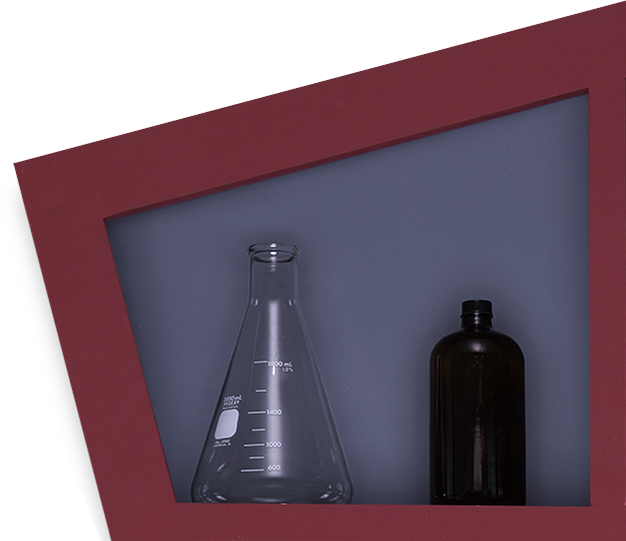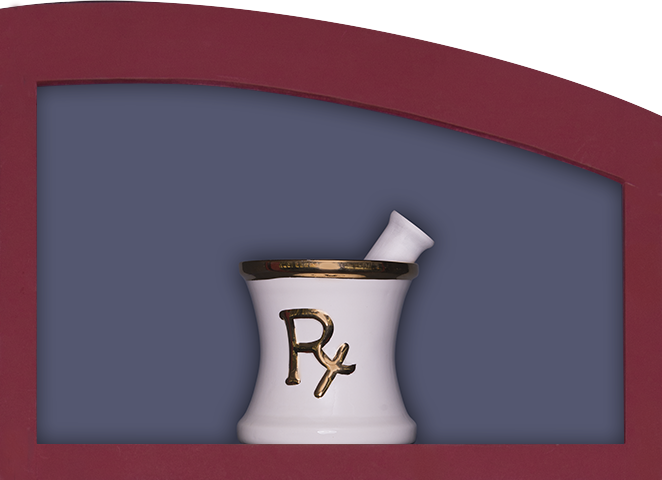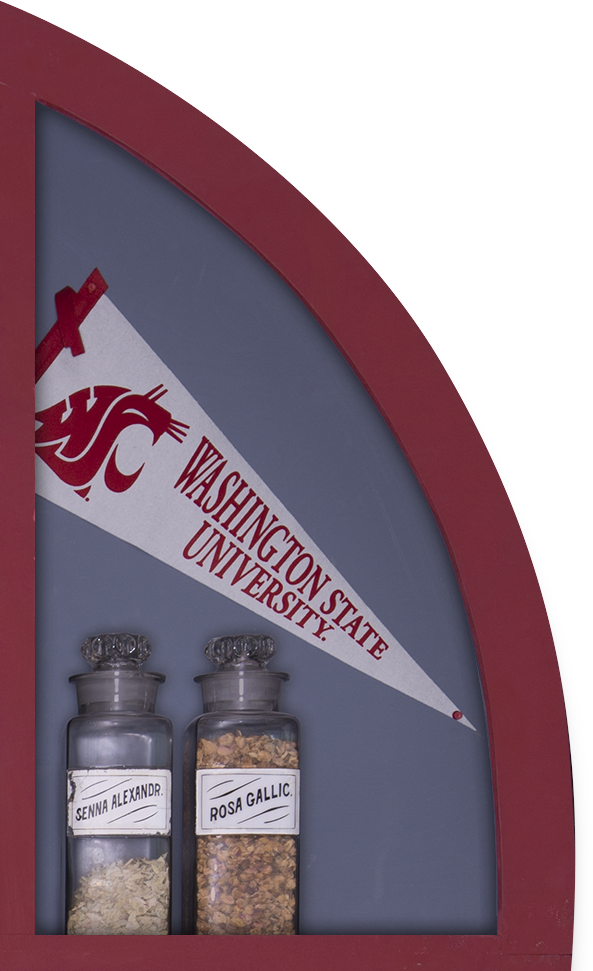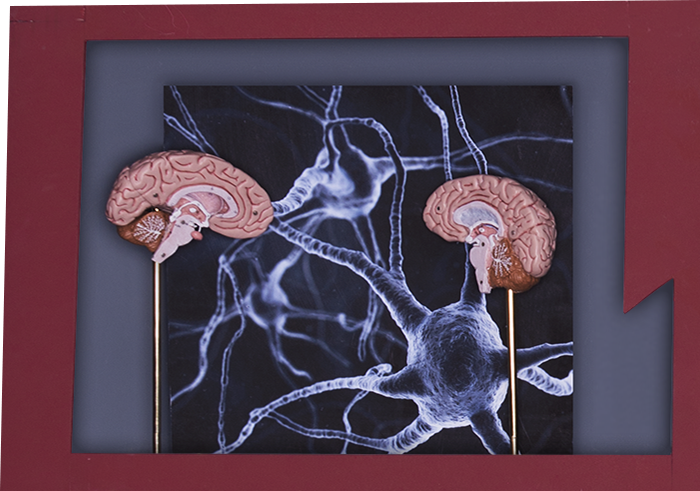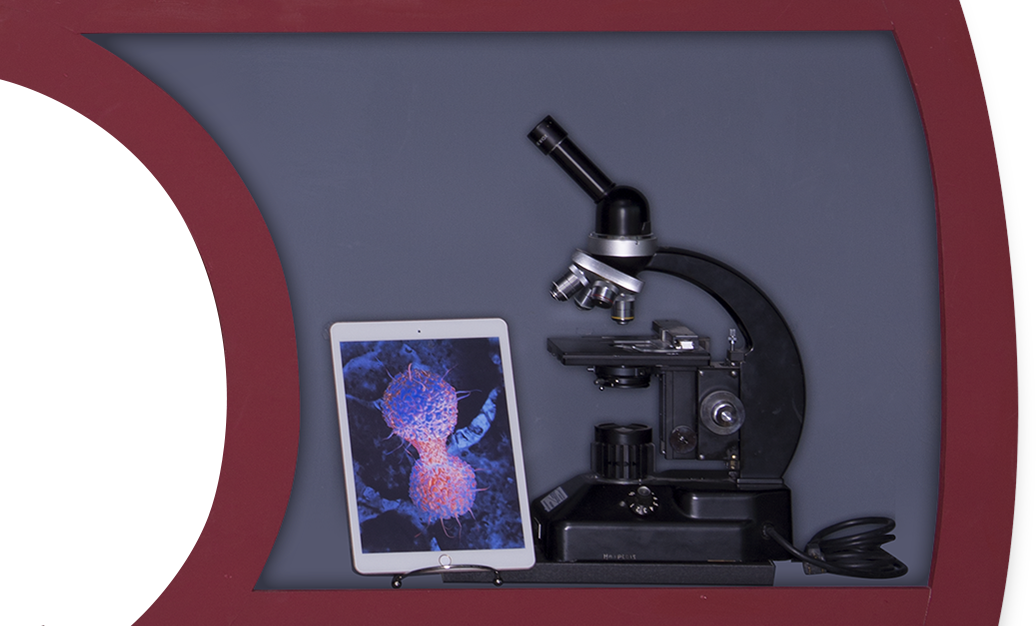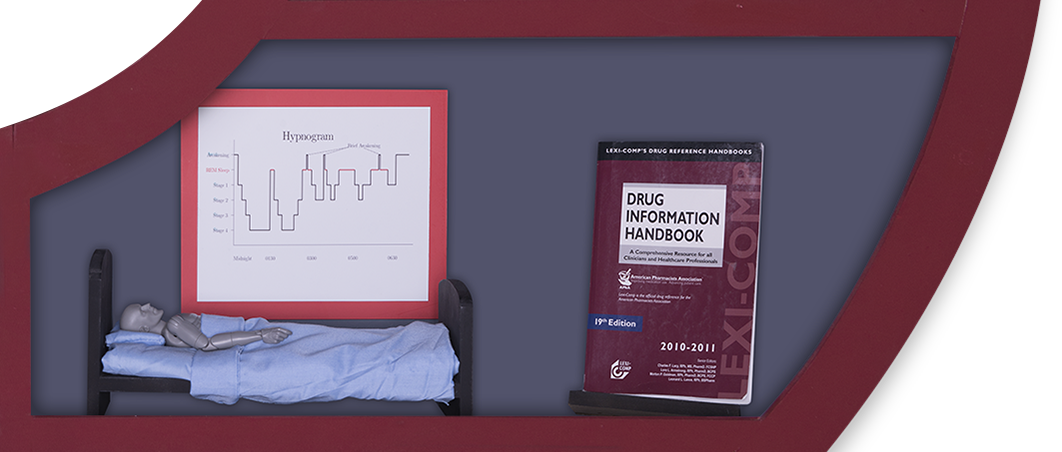A life-size shadow box sculpture celebrates 125 years of pharmacy at WSU. It is located in the lobby of the Pharmaceutical & Biomedical Science Building on the Spokane campus.
Click on items in the photos below to learn more about the accomplishments, milestones, and contributions of Washington State University in the world of pharmacy.



Lab Glassware
Glass has a long history in science. Because glass is essentially inert, it is perfect for containing the otherwise uncontainable such as strong acids, bases, and solvents. Glassblowing probably started with the Phoenicians in the first century B.C. Most lab glassware is mass produced, but specialized pieces are still made by hand. WSU and the University of Idaho share the services of a glassblower for custom work.
Physician’s Creed
Generally thought of as part of the Hippocratic Oath, in fact these exact words are not in the ancient creed (though they are certainly in keeping with the oath’s spirit). The phrase was probably introduced to medical culture by Worthington Hooker in his 1847 book Physician and Patient. Hooker said he got the phrase from French clinician A.F. Chomel; the phrase may have cropped up in Chommel’s lectures.
Anatomy and Physiology
All medical practitioners need a thorough knowledge of anatomy and physiology—a prerequisite that goes back to Galen. Galen was a first century AD Greek physician and philosopher. Roman Emperor Marcus Aurelius said of Galen, “He is first among doctors and unique among philosophers.”
The Spirit of Health
Cougar spirit is well known—as is the relation between good health and mood. A spirited attitude towards daily life generally improves overall health—especially when our definition of health is broadened beyond the absence of organ pathology and made inclusive of a repertoire of skills that enable us to succeed wherever we are.
Medicinal Plants
Colonial Americans were introduced to Boneset by Native Americans, who used it as a fever breaker. Many plants were widely used in treating patients, so pharmacy education often included botany and horticulture as part of the curriculum. In the first half of the 20th century, WSU maintained a drug garden where students learned first hand the characteristics of medicinally valuable plants.
Growth of Health Sciences
An 1896 issue of The Evergreen cites “inquiries for opportunities” to take pharmacy courses as one of the motivating reasons the program was created. The growth of health sciences at WSU has been driven by the need to serve the people of the region, especially in rural areas where health care providers and facilities can be few and far between.
Drop by Drop
Pipettes are ubiquitous in labs the world over, and are used to measure liquids. There are many kinds of pipettes, each type tailored to a specific purpose. Pipettes have been in use for hundreds of years, but the first patent for one was issued in 1924. Since then, accuracy, ergonomic function (carpal tunnel syndrome was once a real issue of researchers doing benchwork), and sterilization have all been dramatically improved. The world’s smallest pipette can measure in the zeptoliter (10-21) range.
Team-Based Education
While all the traditional methods of teaching pharmacy are still employed, team-based learning is now used to give students hands-on experience. Students prepare before class, and in class work together to arrive at solutions. Interprofessional education (IPE) is also employed. With IPE, students from the various health science programs work side by side with expert professionals. Both team-based learning and IPE result, some studies indicate, in better patient-focused care.
Discovering Germs
The function of the lungs was first grasped by Galen and others over 2,000 years ago. Only with the development of the germ theory of disease did we began to realize the lungs’ role in disease transmission. The germ theory was proposed as early as the 1550s but it wasn’t until the 1850s that Louis Pasteur and Robert Koch produced evidence of bacteria as culprits in disease. Viruses were discovered a few decades later. Alas, though, there is still no cure for the common cold.
Custom Compounding
Pharmaceutical compounding is an ancient practice. Ancient civilizations compounded ingredients for health, grooming, and religious reasons. Modern compounding arose with the sciences of modern medicine, chemistry, and the isolation of active ingredients. While compounding has largely been replaced by mass production of medications, pharmacists still compound medicines to facilitate delivery (turning a solid into a liquid, for instance), to eliminate a non-essential ingredient the patient is allergic to, or to adjust flavor or texture.
Health Sciences
In 1891, the Board of Regents of the newly formed Washington Agricultural College and School of Science decided that the future WSU should offer four courses of study: agriculture, mechanical arts, domestic science, and pharmacy. Now, pharmaceutical science is part of a much larger effort to train health care professionals. Starting in the 1960s, WSU established a program in nursing. In 1989, the Spokane campus was established. WSU offers health sciences education in several locations throughout the state. In 2017, WSU will admit its first medical school class.
Let’s Get Small
Getting a look at the tiny and the hidden has long been a key element of observational science. The microscope opened our eyes to the very small and enabled the development of the germ theory of disease. The first microscopes (and telescopes) were developed in the Netherlands in the first decades of the 17th century. Electron microscopes made the molecular level of life visible. When, in the 1930s, WSU researchers first read about an electronic microscope developed in Germany, they built one from spare and handmade parts.
Mortar & Pestle
Since ancient times, a wide variety of substances have been crushed in a wood, ceramic or stone bowl called a mortar with a club-shaped pestle. Large wooden mortars and pestles are operated by multiple people to hull or husk grains. Spices and food ingredients have long been prepared using mortars and pestles. Pesto gets its name from the pestle. And medicines, too, are prepared and customized with these tools which are now icons of pharmaceutical science.
Kelvin Lynn
From antimatter to solar cells, Regents Professor and director of WSU’s Center for Materials Research Kelvin Lynn has covered a lot of ground during his career. One of the most significant developments he’s made has been in the area of growing crystals for use in lasers. Washington State is great crystal-growing country because of its abundance of cheap power. Perfectly formed crystals require lots of stable power over long periods. Among a vast number of uses, crystals are used as radiation detectors in medical imaging instruments.
Drug Information Center
WSU’s Drug Information Center provides information about drug interactions, side effects, new drug information, and identification of unknown capsules and tablets to medical practitioners in the state of Washington.
Speech & Hearing
The WSU College of Pharmacy shares the Spokane campus with many other programs in the health sciences, including the program in speech and hearing sciences. Graduates of the speech and hearing program develop treatments for the physiological, neurological, behavioral, and psychological dimensions of normal and disordered communication across the lifespan.
A Well-Rounded Education
Today’s pharmacy student benefits from a strong science education and a philosophy of continuing education that was established more than 100 years ago. Unlike a century ago, today’s pharmacist is trained as part of a team of health care providers. Modern pharmacists are taught to communicate medical information in understandable language, give flu shots, take blood pressure, test blood glucose, assess a patient’s overall health, and much more.
Them Bones
WSU scientists are developing ways to 3D print bone scaffolding that both promotes and expedites natural recovery from injuries and diseases.
Compounding Scale
A symbol of justice, trade, and drug compounding, the scale has a long history. In use in the Indus Valley by about 2000 B.C., the accuracy of scales became increasingly important as they were used to weigh coins, letters and packages for mailing and shipping, and materials for medicines. Digital scales dramatically improve both accuracy and our ability to measure minute quantities of materials, both important to the pharmacist.
Cancer
Descriptions of cancer begin appearing in ancient Egyptian papyri around 1600 B.C. The word “cancer” was probably coined by the “Father of Medicine,” Hippocrates in the 4th century B.C. Hipocrates described outwardly visible tumors with the Greek word for crab. Later, the Greek physician Galen introduced the word oncos (“swelling”) for all tumors, reserving “cancer” for malignant tumors. Early therapies included diet and surgery. Modern molecular biological and gene treatments being developed at WSU and elsewhere offer hope for previously untreatable cancers.
Entrance Requirements
In its earliest days, WSU’s pharmacy program’s entrance requirements were simple: you had to be at least 16 years old, and able to pass your courses. But that didn’t get you a license to hang out your pharmacy shingle. State law required not only a diploma from a program in pharmacy but also four years’ practical experience in drug stores where medicines were compounded. The total time to become a practicing professional hasn’t changed.
Stethoscope
The stethoscope was invented in 1816 by a French physician, R.T.H. Laennec, who was squeamish about touching his patients—especially female ones. A craftsman, Laennec made and stethoscopes. You could pick one up for a couple francs, along with a copy of his treatise on “auscultation” (listening to the body’s internal sounds). The stethoscope has certainly been refined since then but still employs the same basic method of operation.
Local Pharmacists
Knowing—and trusting—a local pharmacist are important factors in good health. Pharmacy’s role in health care is rapidly expanding beyond dispensing medicines to include monitoring patient health, and advising patients and other practitioners on medication therapies. Local pharmacies are often ideal points of contact to help raise awareness of diseases and health issues.
Apothecary
Our word apothecary comes from the Latin apotheca, indicating a place where wine and herbs are stored. In London, the apothecary’s trade can be traced back to the 12th century. Apothecaries sold spices and herbs but also prepared medicines (often mixing plant materials ground in a mortar with a pestle, and then mixed with wine). By the 18th century, apothecaries had won the right to prescribe and dispense medicines, making the apothecary trade a forerunner of modern pharmaceutical science.
Doctor’s Bag
Bags and boxes have long been used by health care professionals to haul their equipment around. In the 19th century, the Gladstone bag was popular among professionals of many trades. Not just doctors, but electricians and plumbers, lawyers and others used the boxy bag to carry the tools of their trades.
Brain Health
Billions of neurons in our brains enable us to think. But diseases like Alzheimer’s kill neurons and destroy lives. WSU scientists are developing drugs to stop Alzheimer’s and other neuron-killing diseases in their tracks.
Research Productivity
WSU is highly ranked for its research productivity. The hallmark of science, engineering, and creative output is the peer-reviewed journal—and pharmacy researchers, graduates, and students have been featured in the best journals in the health sciences, including Cell, Diabetes Spectrum, and many more.
Microscope Slides
The earliest microscope slides date from the 18th century. Back then, a specimen (for instance, a seed) was simply placed on a piece of wood or bone. A little later, specimens were places between two pieces of mica in order to allow the transmission of light though and around the specimen, thus giving the microscopist a much better view. Slides are now standardized in size and thickness. Specialized types of slides include the graticule, which has a grid of lines that enable researchers to easily count cells or other minute objects.
Early Lenses
The use of lenses to magnify tiny objects dates back to the 1590s. But 2,000 years ago, Ptolemy observed that light bent when it passed through water and was able to calculate the angle of refraction. Not long after, people began using bits of glass as magnifiers and burners. To Latin-speaking people, these bean-shaped bits of glass looked like lentils, which is where we get out word lens.
To Sleep, Perchance to Dream
Sleep is one of medicine’s final frontiers. Sleep loss degrades health, safety, and productivity while increasing the chance of errors and accidents. The WSU Sleep and Performance Research Center aims to understand the neurobiology of sleep and sleep loss, and the effect of sleep loss on metabolism, immune function, cognitive performance and behavior, all with the aim of ensuring adequate, recuperative sleep and/or mitigating the effects of inadequate sleep.
Allen I. White
Allen I. White was a highly regarded leader during a time (1940–1979) when a flood of new technical and scientific knowledge was having a profound effect on the delivery of health care. His challenge was to ensure that WSU faculty responded with fresh approaches in pharmaceutical education, a trend of pedagogical innovation and excellence that continues at WSU today.
Porcelain
Golden and Diamond alumni used this china at a luncheon celebrating the accomplishments of their pharmacy careers. Because of its durability and impermeability, porcelain has played an important role in the history of pharmacies and apothecaries, as storage containers for plant and other materials, as well as mortars and pestles. The manufacture of porcelain was well developed by the 3rd century B.C. in China. The word porcelain comes from Italian porcellana, meaning “cowrie shell” because of its resemblance to the smooth, translucent surface of the shell.


